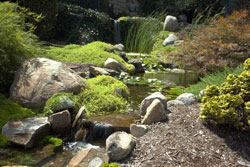| Home A B C D E F G H I J K L M N O P Q R S T U V W X Y Z |
|
Home |
Creating a Japanese GardenThe growing fascination with Oriental culture has led many garden aficionados to consider creating a Japanese garden. These are just some of the key features to help you in selecting the right accessories, and how they create a look and ambience that is very different from the Western formal garden. Both formal Western and Japanese gardens will use water features, like a pond. However, the Zen aesthetic and the belief that one must embrace “things as they are” dictates that the water must be pure, and natural. Fountains are forbidden, and the pond's shapes must not look contrived. Streams or waterfalls are preferred, but they must have an “organic” look: never place them in the center, and incorporate a few asymmetrical details and imperfections. Many Japanese ponds will have small islands in the center, or a miniature waterfall. These act as a focal point. Many times the ponds are edged with rough rocks or pebbles, rather than polished stone or tile. 
Western gardens also tend to be very structured and symmetrical. The Japanese interpret this as a manipulation of Nature. They would rather preserve Nature, in its spontaneity and irregularity. For them, pure symmetry is too logical — a garden should be spiritual, which means openness to Life and its uniqueness. That is why Japanese gardens tend to look a little “wild”. This doesn’t mean that they’re unkempt, but that the design establishes a pattern and then occasionally “breaks” it so it looks less contrived. The designs also tend to use a lot of curves, rather than lines (like a winding path) and will use elements that have a natural, rough finish. For example, the wooden bridge will make use of planks of different sizes, and will leave in imperfections like crooked edges or knobs. Western gardens also tend to use sculptures (from Greek goddess to the ever-famous gnomes). The garden features are then organized in such a way to direct the eye to that sculpture. One example is hedge mazes or carefully landscaped bushes encircling a stone statue. For Japanese, this is another sign that human beings are restructuring reality rather than embracing its quirks. Even the sculpture is seen as a human interpretation of art rather than seeing Nature as art. That’s why instead of sculptures, Japanese gardens will just artistically arrange elements of nature, such as a pile of rocks in different colors and sizes. Even if the gardener “fixes” the arrangement, the whole point of the exercise is to make it look as natural and effortless as possible — as if you had discovered a hidden garden paradise, rather than made one yourself. There may be water basins, stone lanterns, stone towers and wells, but these are never focal points. They are tucked in a corner, sometimes behind a veil of leaves, or are kept small. The colors are kept natural and subtle: grays, browns, and other neutrals. Marble and other “finished” textures, or brightly colored furniture, are frowned upon. Instead, use wood, stone or bamboo. If you need to incorporate lights or sprinkler systems for practical purposes, keep them unobtrusive. About The Author: |
|
|
|
|
|
Glossary References Links Contact
|